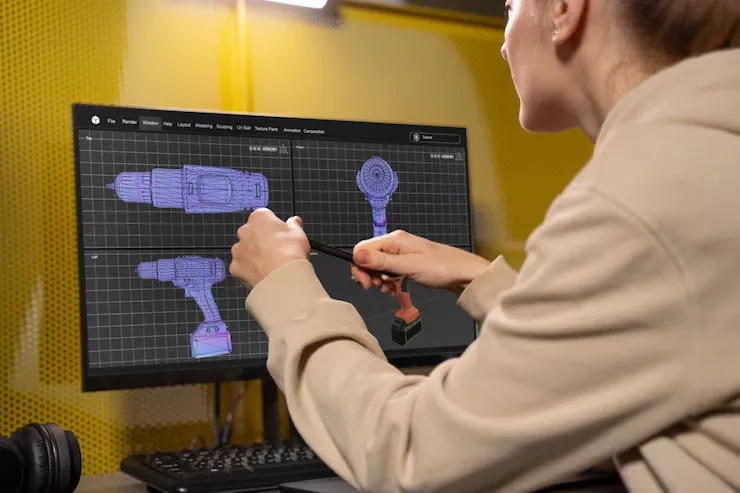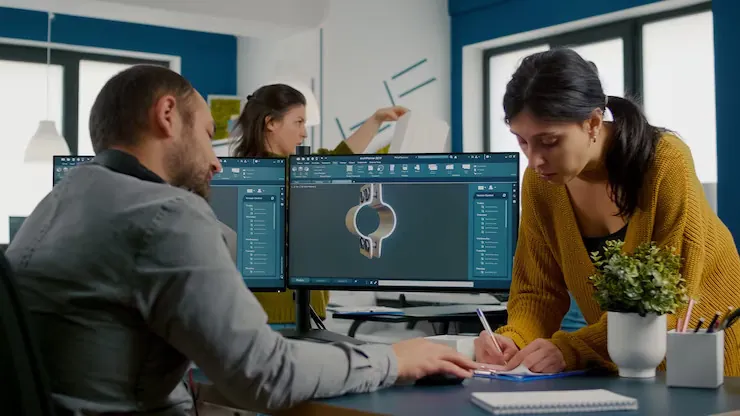Three-dimensional computer-aided design (3D CAD) is a powerful tool used extensively in the design and manufacturing industries. With 3D CAD software, designers can create detailed digital models of products, buildings, and other objects. These models allow designers to test and refine their designs, making it easier to identify and address any potential problems before moving on to the physical production phase. In this article, we will discuss the ways in which 3D CAD models are used in the design process.
Benefits of 3D CAD modeling
One of the main benefits of 3D CAD modeling is that it allows designers to visualize their designs in three dimensions. This means that they can see the product or object from all angles, and make changes as necessary. For example, a designer may create a 3D CAD model of a car, and then make adjustments to the body shape, wheel size, and other features until they are satisfied with the overall design. With traditional 2D drawings, it is much more difficult to get a sense of the final product, and it can be challenging to make changes without starting over completely.

Advantages of 3D CAD modeling:
Another advantage of 3D CAD modeling is that it enables designers to test the functionality of their designs. For example, a product designer may create a 3D model of a new piece of equipment, and then simulate how it would operate under various conditions. This can help identify any potential issues before the product is produced, saving time and money in the long run. In some cases, 3D CAD models can even be used to create animations or simulations of products in action, which can be incredibly helpful for marketing or training purposes.
3D CAD modeling can also be useful for collaboration between designers, engineers, and other stakeholders. With 3D models, all parties can view and modify the design in real time, allowing for more efficient communication and collaboration. This is particularly important in large-scale projects, where many different teams may be working on different parts of the project simultaneously.
Finally, 3D CAD models can be used to create detailed technical drawings that can be used in the manufacturing process. These drawings include all of the necessary information about the product, including dimensions, materials, and assembly instructions. This ensures that the product is manufactured to the exact specifications of the designer, reducing the risk of errors or inconsistencies in the final product.
What are 3D CAD models?
3D CAD (Computer-Aided Design) models have revolutionized the design process in many industries. From architecture to manufacturing, 3D CAD models have become an essential tool in the design and prototyping process. In this article, we will explore how 3D CAD models are used in the design process.
Visualization and Conceptualization
One of the primary uses of 3D CAD models is to help designers visualize and conceptualize their ideas. Before the advent of 3D CAD models, designers had to rely on sketches and two-dimensional drawings to communicate their ideas. However, with 3D CAD models and CAD Drafting services, designers can create realistic, three-dimensional representations of their designs, allowing them to explore different design options and make changes quickly.
Detailed Design and Engineering
Once a concept has been established, 3D CAD models are used to create detailed designs that take into account all the necessary engineering requirements. For example, in architecture, 3D CAD models can be used to ensure that a building’s design is structurally sound, while in manufacturing, 3D CAD models can be used to optimize the production process and reduce waste.
Prototyping and Testing
After the detailed design is complete, 3D CAD models are used to create prototypes of the design. These prototypes can be tested and refined before production begins, ensuring that any issues are identified and resolved before they become more significant problems.
Collaboration and Communication
3D CAD models allow designers to collaborate with other team members and stakeholders more effectively. By creating a 3D model, designers can share their designs with others, allowing them to provide feedback and make suggestions for improvement. This collaboration can help streamline the design process, reducing errors and speeding up the time to market.

Marketing and Visualization
Finally, 3D CAD models are also used in marketing and visualization. By creating a realistic 3D model of a product or building, designers can help stakeholders and customers visualize the end product before it is even produced. This visualization can be used to market the product, generate interest, and secure funding.
Conclusion:
3D CAD models are an essential tool in the design process. They allow designers to visualize and conceptualize their ideas, create detailed designs, prototype and test their designs, collaborate with others, and market and visualize their products. With the increasing demand for efficient and effective design, 3D CAD models are likely to remain an essential part of the design process in many industries.






Comments closed.